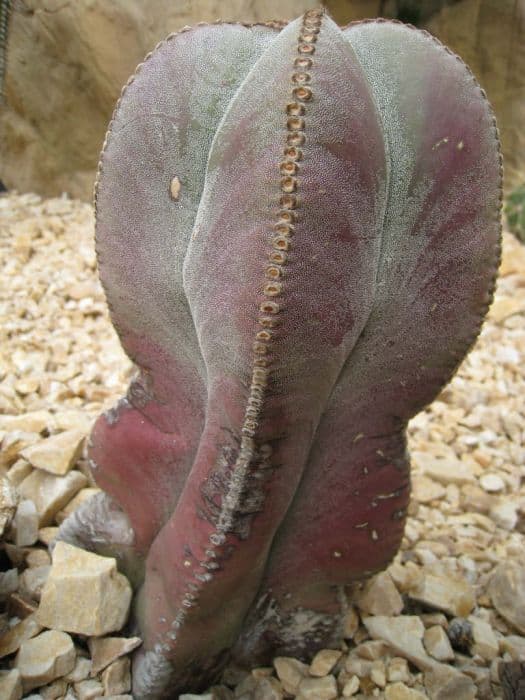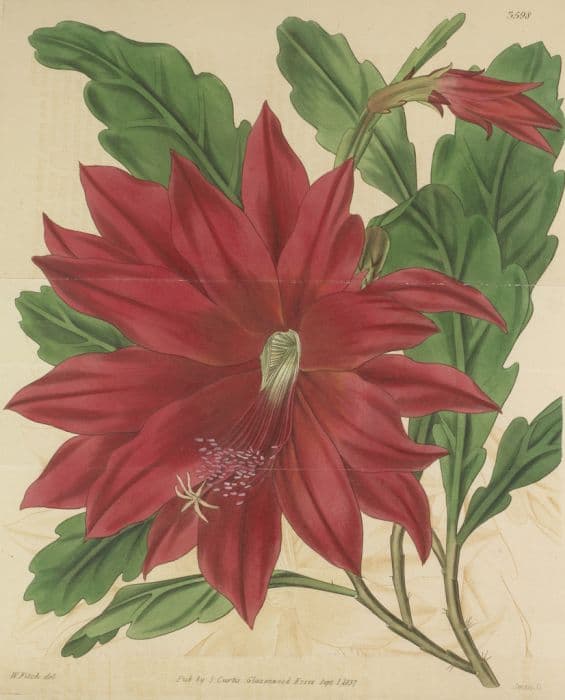Lemon Ball Cactus Mammillaria pringlei

ABOUT
Mammillaria pringlei, commonly known as the lemon ball cactus, is a spherical or slightly elongated succulent. Its captivating appearance is characterized by a green body densely covered in white spines. The interplay of colors gives it a snowy or frosty look, accented by hints of yellow due to its lemony spines. One of the distinctive features of this plant is its tendency to produce rings of vibrant pink flowers that encircle its top, creating a striking contrast against the white and green backdrop. These flowers eventually give way to small, red fruit that adds another layer of visual interest to the cactus. The overall texture is a combination of the sharp, needle-like spines intermixed with finer, hair-like spines, giving it a richly textured, almost fluffy appearance.
About this plant
 Names
NamesFamily
Cactaceae.
Synonyms
Lemon Ball Cactus, Rose Pincushion Cactus, Pringle's Mammillaria.
Common names
Chilita pringlei, Ebnerella pringlei, Neomammillaria pringlei
 Toxicity
ToxicityTo humans
The Lemon Ball Cactus is not considered to be toxic to humans. There are no significant symptoms of poisoning associated with ingesting this plant, as it is generally not consumed due to its nature as a cactus with spines rather than being a food source. However, it is always advisable to exercise caution and avoid ingesting any part of ornamental plants unless they are known to be edible.
To pets
The Lemon Ball Cactus is also not considered to be toxic to pets. It does not contain any known toxic compounds that would cause poisoning if ingested. Nonetheless, the physical danger comes from the spines, which can cause injury if a pet attempts to chew or swallow the cactus. If ingested, the spines may cause mechanical damage, such as punctures or internal injuries. It is always prudent to keep pets away from cacti and succulents to prevent accidental injuries.
 Characteristics
CharacteristicsLife cycle
Perennials
Foliage type
Evergreen
Color of leaves
Green
Flower color
Pink
Height
1 foot (30 cm)
Spread
1 foot (30 cm)
Plant type
Cactus
Hardiness zones
9
Native area
Mexico
Benefits
 General Benefits
General Benefits- Aesthetic Appeal: Mammillaria pringlei, commonly known as the Lemon Ball Cactus, adds visual interest to gardens and homes with its spherical shape and bright yellow flowers.
- Ease of Care: Being a cactus, it requires minimal maintenance, making it ideal for busy gardeners or those new to plant care.
- Drought Tolerance: The Lemon Ball Cactus is highly drought-resistant, conserving water and thriving in arid conditions where other plants may struggle.
- Small Size: Its compact size makes it suitable for small spaces, terrariums, and as a desktop plant.
- Pollinator Attraction: When in bloom, its flowers can attract pollinating insects, benefiting the local ecosystem.
- Education and Hobby Interest: Cultivating Mammillaria pringlei can be an educational experience, offering insight into cacti and succulent care, and providing a rewarding hobby.
 Medical Properties
Medical PropertiesThis plant is not used for medical purposes.
 Air-purifying Qualities
Air-purifying QualitiesThis plant is not specifically known for air purifying qualities.
 Other Uses
Other Uses- Mammillaria pringlei, also known as Lemon Ball Cactus, can be used as a natural dye source; the fruit and body of the cactus may provide pigments for coloring fabrics.
- The firm flesh of the cactus can be used for creating cactus-based stamps as a craft activity, where shapes are carved into the plant tissue and used to stamp designs with ink.
- As a resilient plant, Lemon Ball Cactus can be used in desert landscaping to prevent soil erosion by establishing a root system that helps hold the soil.
- The characteristic spines of the cactus have historically been used for small-scale fishing tackles, like hooks and barbs, by indigenous peoples.
- The striking appearance of the Lemon Ball Cactus makes it a popular choice for still-life photography, aiding in the development of visual arts and botanical photography skills.
- The Lemon Ball Cactus lends itself to the creation of botanical illustrations and is prized for its geometric shapes and textures in the art community.
- Due to its unique shape and growth pattern, Mammillaria pringlei can be used in educational settings to teach about plant adaptation and desert survival strategies.
- In hobbyist model environments, such as model railroads or dioramas, the cactus can serve as a realistic miniature plant for creating desert scenes.
- The Lemon Ball Cactus is sometimes used in traditional celebrations and ceremonies as a symbol of resilience and adaptation in arid climates.
- The cactus can also be fermented to create eco-friendly biofuels on a small, experimental scale due to the sugars found in the plant tissues.
Interesting Facts
 Feng Shui
Feng ShuiThe Mammillaria pringlei, commonly known as the Lemon Ball Cactus, is not traditionally used in Feng Shui practice.
 Zodiac Sign Compitability
Zodiac Sign CompitabilityThe Lemon Ball Cactus is not used in astrology practice.
 Plant Symbolism
Plant Symbolism- Resilience: Mammillaria pringlei, commonly known as the "Lemon Ball Cactus," often symbolizes resilience due to its ability to thrive in harsh, arid environments.
- Independence: As a cactus that primarily lives isolated amongst rocky terrains, it represents self-sufficiency and independence.
- Protection: The sharp spines of the Lemon Ball Cactus are seen as a symbol of protection, warding off negative forces and safeguarding one’s space.
- Adaptation: This plant's ability to adapt to extreme conditions makes it a symbol of versatility and the ability to endure change.
 Water
WaterThe Lemon Ball Cactus should be watered sparingly, allowing the soil to completely dry out between waterings. Typically, during the active growing season in spring and summer, watering once every 7-10 days with about 5-8 ounces of water is sufficient. In the fall and winter months, reduce watering to once every 4-6 weeks, careful not to overwater as this can lead to root rot. It is best to use the soak and dry method, thoroughly drenching the soil and then letting it dry out completely.
 Light
LightThe Lemon Ball Cactus thrives in bright, indirect light but can also tolerate some direct sunlight. The ideal spot is near a south-facing or east-facing window where it will receive plenty of light without the harsh midday sun, which could scorch its skin. If the light is too low, the plant may become etiolated or stretched out.
 Temperature
TemperatureThe Lemon Ball Cactus prefers a warmer climate with temperatures ranging from 70-80 degrees Fahrenheit during the day and no lower than 50 degrees Fahrenheit at night. It can survive in temperatures up to about 100 degrees Fahrenheit but should be protected from frost, which can damage the plant.
 Pruning
PruningPruning the Lemon Ball Cactus is generally not required as it maintains its shape well. However, any dead or damaged spines can be gently removed to keep the plant healthy. Pruning is best done in spring or early summer when the plant is actively growing.
 Cleaning
CleaningAs needed
 Soil
SoilFor Lemon Ball Cactus, prepare a well-draining soil mix with one part potting soil, one part coarse sand, and one part perlite or pumice. Aim for a pH between 6.0 and 7.5 for optimal health.
 Repotting
RepottingLemon Ball Cactus should be repotted every two to three years, best done during the warmer seasons when the plant is actively growing.
 Humidity & Misting
Humidity & MistingLemon Ball Cactus thrives in low humidity conditions and does not require high levels of atmospheric moisture.
 Suitable locations
Suitable locationsIndoor
Place Lemon Ball in bright, indirect light, and low humidity.
Outdoor
Plant Lemon Ball Cactus in well-drained soil, full sun to partial shade.
Hardiness zone
9-11 USDA
 Life cycle
Life cycleMammillaria pringlei, commonly known as Lemon Ball Cactus, starts its life as a tiny seed that germinates in well-draining, sandy soil, typically under the shade of nurse plants in the wild, or in cultivation under controlled conditions. The seedling stage is characterized by the emergence of a small, rounded green shoot which over time develops into a spherical stem with small areoles from which spines emerge. As it matures, the plant grows more globular and can eventually produce offsets, or "pups", around its base, leading to a clustering habit. During its adult phase, which can take several years to reach, the Lemon Ball Cactus blooms in spring or early summer, producing pink to red funnel-shaped flowers from the crown of the stem. Following pollination, which is often facilitated by insects, the flowers develop into fleshy fruits containing seeds that, when dispersed, can give rise to new plants, thus continuing the life cycle. The Lemon Ball Cactus is relatively slow-growing and long-lived, with individual plants often surviving for decades under optimal conditions.
 Propogation
PropogationPropogation time
Spring to Summer
Propogation: The Rainbow Pincushion, known scientifically as Mammillaria pringlei, is most commonly propagated by seeds, with the optimal propagation time being in spring when temperatures are warmer. To propagate by seeds, firstly, a well-draining cactus mix should be used. The seeds are then evenly distributed on the surface of the soil and lightly covered with a thin layer of sand or fine gravel. The seed tray should be kept in a warm place with indirect sunlight and the soil must be kept moist, but not waterlogged, until germination occurs, which can take anywhere from a week to several months. A plastic cover or glass pane can help maintain humidity levels, but it should be removed frequently to prevent mold growth. Once seedlings are big enough to handle, they can be transplanted into individual pots.








